10+ Explanation Incident Report Letter Examples to Download
What comes to mind if you hear the word incident? You can automatically assume something happened which is true that is what it means. How about the word report? You may say a written document. Lastly, the word letter? Another document but with a different purpose. If you mix all three words together, you will immediately get an incident report letter. Any thoughts that you may have about this kind of matter? Have you ever had to write a report letter to someone about something? The reasons can differ but the most common is to ask for help during an incident that you either witnessed or you were a part of it.
What is Explanation Incident Report Letter?
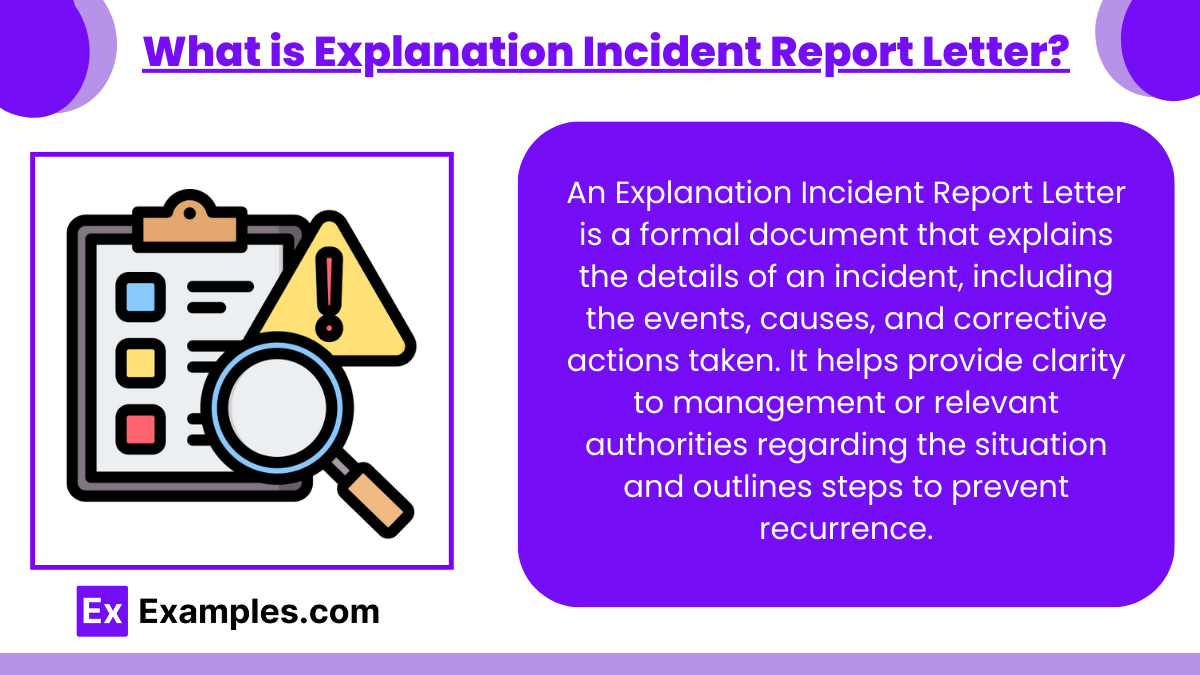
Explanation Incident Report Letter Examples Bundle
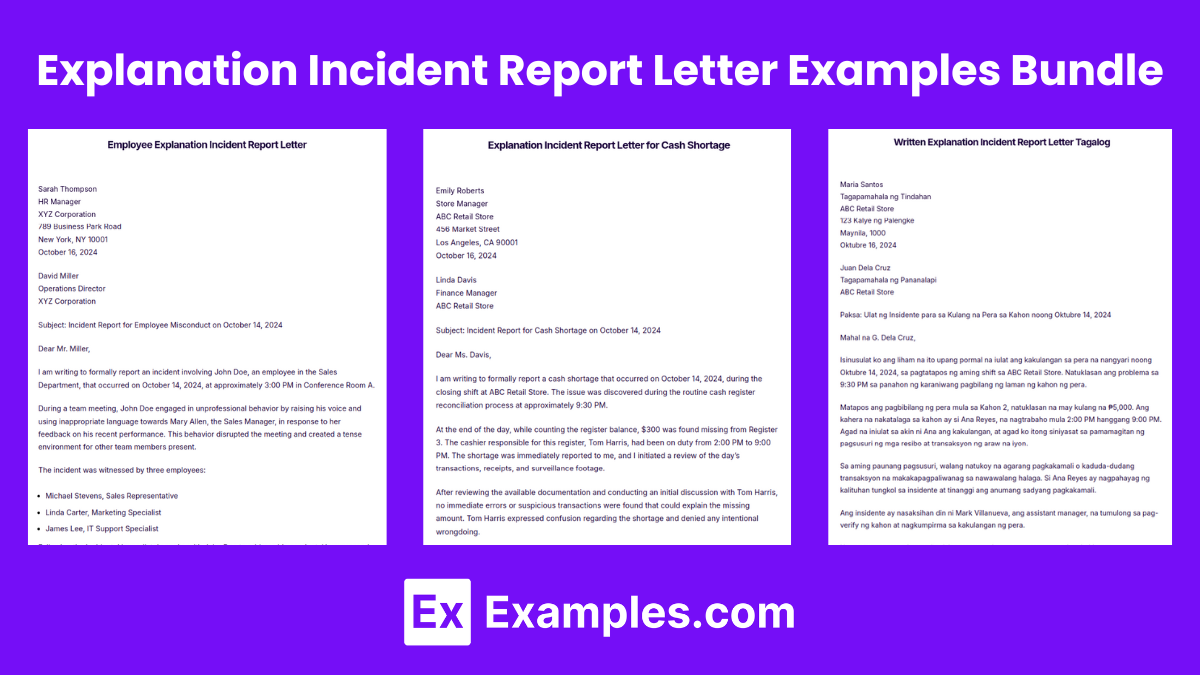
Download Explanation Incident Report Letter Examples Bundle
Explanation Incident Report Letter Format
Date and Time of the Incident
The incident took place on [Date] at approximately [Time].
Location of the Incident
The incident occurred at [Specific Location: room number, address, etc.].
Individuals Involved
The following individuals were involved in the incident:
- [Person 1 Name], [Role/Position]
- [Person 2 Name], [Role/Position]
Description of the Incident
On [Date], at around [Time], [Describe what happened in detail, including how the incident started, what occurred during the incident, and how it concluded].
Witnesses
The incident was witnessed by the following individuals:
- [Witness 1 Name], [Role/Position]
- [Witness 2 Name], [Role/Position]
Immediate Actions Taken
As soon as the incident occurred, the following actions were taken:
- [List actions, e.g., first aid, calling emergency services, informing management, etc.]
Impact of the Incident
The incident resulted in the following consequences:
- [Describe any injuries, damages, disruptions caused by the incident]
Further Actions/Recommendations
To prevent such incidents in the future, the following actions or changes are recommended:
- [List recommendations, policies, or measures that should be implemented]
Supporting Documents/Attachments
Enclosed with this report are the following documents related to the incident:
- [List of attached documents, e.g., photographs, witness statements, medical reports, etc.]
Explanation Incident Report Letter Example
Jane Doe
Shift Supervisor
ABC Manufacturing Company
123 Industrial Blvd
Springfield, IL 62701
October 15, 2024John Smith
Operations Manager
ABC Manufacturing Company
123 Industrial Blvd
Springfield, IL 62701Subject: Incident Report for Workplace Accident on October 12, 2024
Dear Mr. Smith,
I am writing to formally report a workplace accident that occurred on October 12, 2024, at approximately 2:15 PM in Warehouse Section B of our facility. At around 2:15 PM, Mark Johnson, a forklift operator, was moving pallets in Warehouse Section B. As he reversed the forklift, Samantha Lee, a warehouse assistant, was walking behind the vehicle, unaware of its movement. Despite the forklift’s backup alarm sounding, there was a miscommunication regarding the safe walking zone, and the forklift struck Samantha Lee, causing her to fall.
The incident was witnessed by David Carter, Warehouse Manager, and Rachel Gomez, Inventory Clerk. Immediate actions were taken following the accident: David Carter administered first aid to Samantha, and emergency services were called. She was then transported to Springfield General Hospital for further evaluation. Samantha Lee sustained minor injuries to her arm and leg and was advised to take three days off for recovery. Fortunately, there was no damage to the equipment or inventory, though work was briefly interrupted for approximately 30 minutes.
To prevent similar accidents, we recommend the following measures:
- Enhanced training on safety protocols for both forklift operators and warehouse personnel.
- Clearer floor markings to designate safe walking zones in high-traffic areas.
- Regular safety briefings at the beginning of each shift to ensure awareness of potential hazards.
Attached to this report are photographs of the accident scene, witness statements from David Carter and Rachel Gomez, and Samantha Lee’s medical report from Springfield General Hospital.
Please let me know if further information or clarification is required. I will be happy to provide additional details.
Thank you for your attention to this matter.
Sincerely,
Jane Doe
Shift Supervisor
Short Explanation Incident Report Letter Example
Jane Doe
Shift Supervisor
ABC Manufacturing Company
October 15, 2024John Smith
Operations ManagerSubject: Incident Report for Accident on October 12, 2024
Dear Mr. Smith,
I am reporting an accident that occurred on October 12, 2024, at 2:15 PM in Warehouse Section B. Mark Johnson, operating a forklift, accidentally hit Samantha Lee, who was walking behind the vehicle. Samantha was treated for minor injuries at Springfield General Hospital.
Immediate actions were taken, and no equipment damage was reported. I recommend additional safety training to prevent similar incidents.
Please contact me for further details.
Sincerely,
Jane Doe
Shift Supervisor
Employee Explanation Incident Report Letter

Explanation Incident Report Letter for Cash Shortage

Written Explanation Incident Report Letter Tagalog

10+ Explanation Incident Report Letter Examples
- Explanation incident Report Letter For Lost Item
- Mistake Explanation Incident Report Letter
- Negligence Explanation Incident Report Letter
- Explanation Incident report letter to Boss
- Explanation Incident Report Letter Philippines
1. Incident Report Letter in Office Template
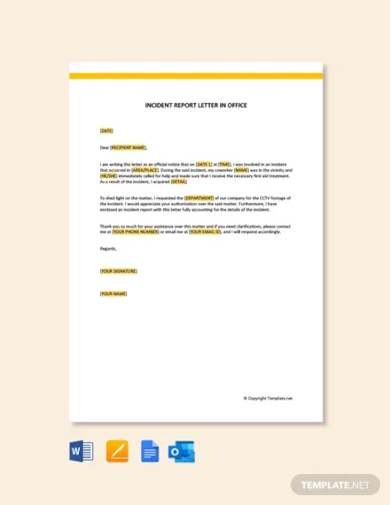
2. Incident Report Letter in Hospital Template
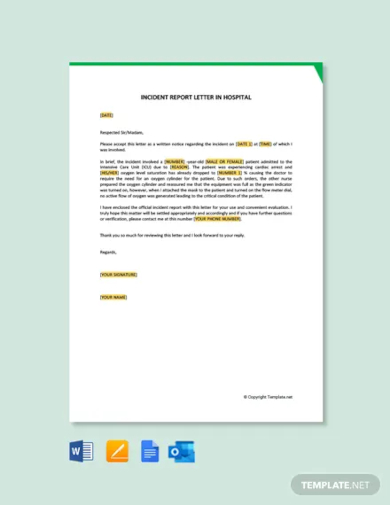
3. Incident Report Letter in Workplace Template
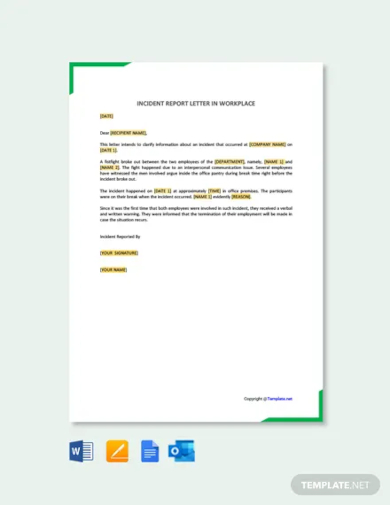
4. Formal Explanation Incident Report Letter

5. Explanation Incident Report Sample Letter Format
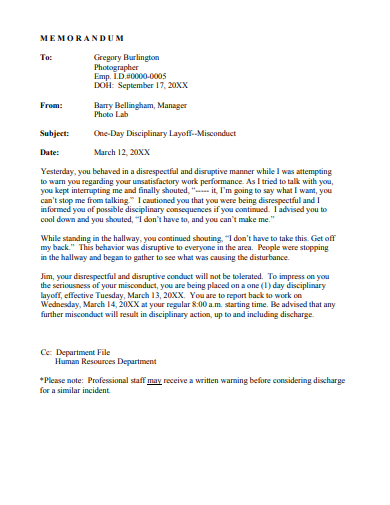
How to Write an Explanation Incident Report Letter?
Writing an Incident Report Letter requires clear communication and detailed information about the incident. Follow these steps to write an effective explanation:
Start by Writing the Date for Your Letter
Just as you write a letter, always remember to add the date. The date has to be when you are writing and not when you are stating when the incident happened. This is part of when writing a letter. When you forget to add it, there may be some issues and complications. Especially if you plan to trace what happened to your report letter.
State the Name of the Person or Company
Following the same format as that of a letter, you should add the name of the person and the company. If you do not know the name of the person or the head of the company or the place that you are sending the letter, you should at least add the name of the business or the company. If there are more than one, look for the person in charge, usually this person has a higher rank or their HR.
Write the Reason for the Letter
At the body of the letter, start with a positive introduction and a positive greeting. Once that is done, write the reason for the letter. Explain what the incident is about. This part usually answers the questions of who, when, why, when and where. Who are the people involved, when did it happen, why did it happen, when did it happen and lastly where did it happen.
Add Some Evidence or Proof
While explaining everything in your report letter, add some evidence or proof of the incident. The purpose for the evidence is to back up your claims. The more evidence you have, the better. Explaining about what had happened should also be there.
End the Letter with a Positive Note
As you end the letter report, end it with a positive note. Avoid ending your letter with something negative or rude towards the person you are sending it for. In addition to that, avoid having to say something hurtful or placing yourself in an awkward situation.
Benefits of Writing an Incident Report Letter
- Accountability: Shows that proper actions were taken, holding individuals or teams accountable.
- Provides Documentation: Ensures there’s a written record of what happened for future reference or investigations.
- Improves Safety Measures: Helps identify issues, leading to improved protocols and preventing future incidents.
- Legal Protection: Serves as evidence in case of legal disputes, helping protect both the organization and the individuals involved.
- Clear Communication: Ensures all parties are aware of the incident details and can respond appropriately.
Uses of an Incident Report Letter
- Workplace Accidents: Used to document accidents involving employees, equipment, or safety hazards.
- School Incidents: Reports for student injuries, misconduct, or on-campus accidents.
- Medical Facilities: Reporting accidents or incidents with patients or staff for legal and medical follow-up.
- Insurance Claims: Supporting documentation for claims regarding damage, injury, or theft.
- Security Incidents: Reporting theft, vandalism, or breaches of security in public or private settings.
- Customer Complaints: Documenting incidents involving customer dissatisfaction, injuries, or conflicts for review and resolution.
Tips for Writing an Incident Report Letter
- Be Clear and Concise: Stick to the facts and avoid unnecessary details. Ensure the report is easy to read.
- Use Chronological Order: Describe events in the order they occurred for better clarity.
- Include All Key Details: Date, time, location, individuals involved, witnesses, and immediate actions are essential.
- Avoid Speculation: Only state facts, not opinions or assumptions.
- Keep It Professional: Use formal language, and maintain a neutral tone.
- Attach Evidence: Include photos, witness statements, or medical reports, if relevant.
- Review Before Submitting: Check for any missing details or errors in the report.
FAQs
What is an incident report letter?
An incident report letter documents and explains the details of an unexpected event or situation, providing a factual account for record-keeping and resolution.
What should be included in an incident report letter?
Include the date, time, location, individuals involved, a clear description of the incident, causes (if known), and any actions taken to resolve or mitigate the situation.
How do I maintain objectivity in an incident report letter?
Use clear, factual language, avoid emotions or assumptions, and focus only on the facts of the incident as they occurred.
Why is it important to write an incident report letter?
An incident report is crucial for documenting events, understanding what happened, and helping prevent future incidents through proper action and analysis.
How soon should an incident report letter be written?
Write the letter as soon as possible after the incident to ensure accuracy and timely documentation.


